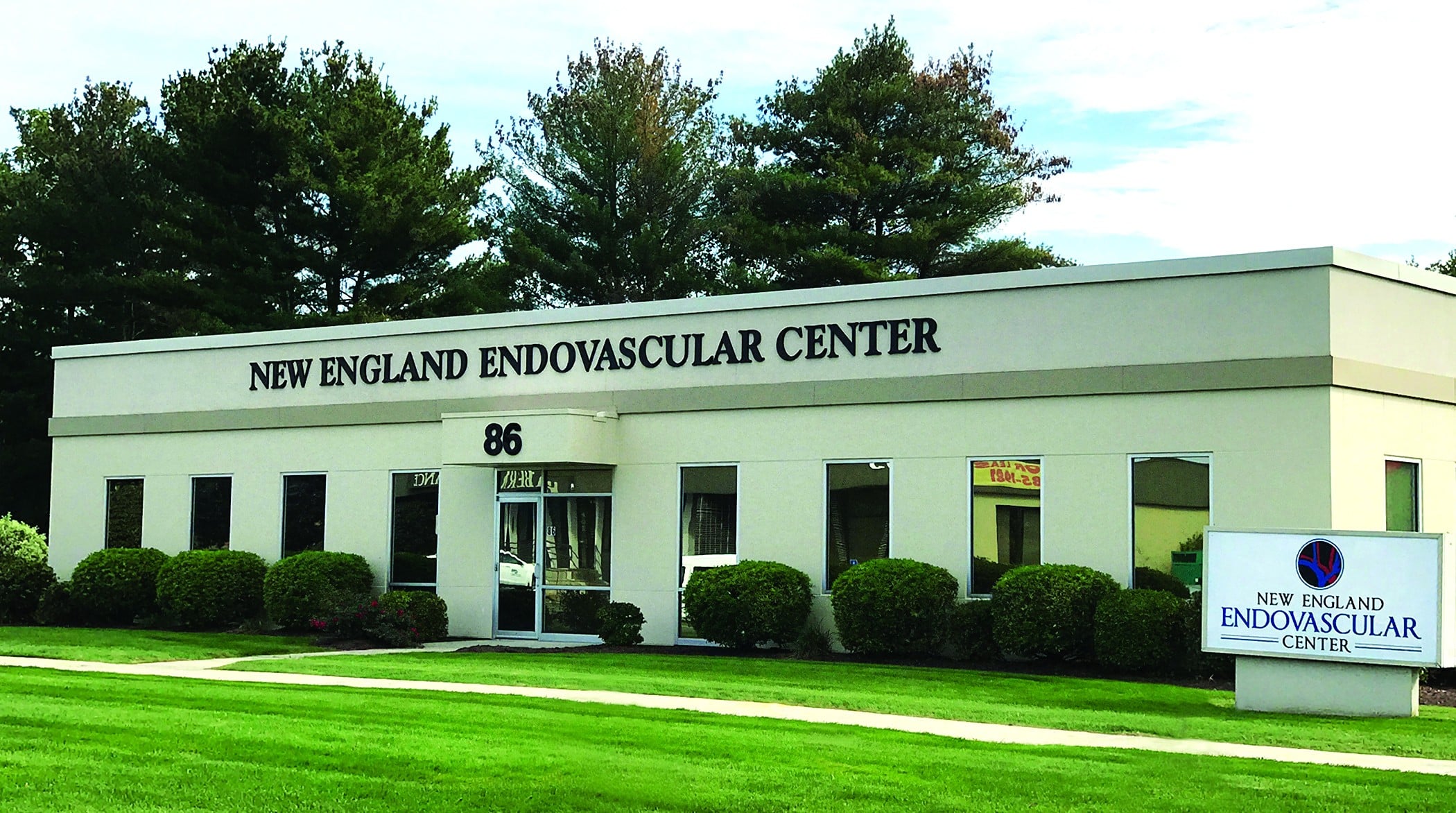New England Endovascular Center offers uterine fibroid embolization (UFE), also known as uterine artery embolization (UAE). Although not appropriate for all patients, UFE is a highly effective treatment for most patients. If you are not a candidate for UFE, there may be excellent medical and surgical options available to you by your OBGYN.
Uterine fibroid embolization is a minimally invasive treatment for fibroids that safely and effectively shrinks the fibroids by cutting off the blood flow to the fibroid. A small tube (called a catheter) is inserted into the artery at the groin or wrist. The catheter is maneuvered under x-ray guidance to the uterine artery that supplies the fibroid(s). Once in place, small beads (called microspheres) are slowly injected. By cutting off blood flow to the fibroids, bleeding is markedly reduced and the fibroid shrinks, thereby alleviating bulk symptoms of the fibroid. As the microspheres are carefully sized, adequate blood flow to the uterus is preserved.
WHAT ARE THE BENEFITS OF FIBROID EMBOLIZATION?
- The Uterus is preserved— This is a minimally-invasive procedure that works directly on the blood vessels. It will deprive fibroids of nutrients, while the remainder of the uterus remains intact. Other treatment options, such as a hysterectomy or a myomectomy, requires surgery to remove the uterus or fibroid(s).
- No large scar– UFE is a pinhole procedure in the skin of your groin or wrist, which does not typically result in scarring. A hysterectomy or myomectomy, are more invasive open or laparoscopic surgeries.
- More than 90% of patients experience symptom relief–
- Decrease in menstrual and breakthrough bleeding
- Decrease in urinary frequency and constipation
- Decrease in pelvic pain, pressure, and bloating
- Less risk than surgery—General anesthesia is not required as the procedure is safely performed with moderate sedation and local anesthesia. In addition, the procedures are performed in an outpatient setting, so you can go home that day. The tiny pinhole incision does not require stitches, and there are superior outcomes, with marked reduction in pain and lower risks. There is less risk of infection and minimal blood loss.
- Quick recovery– Most women are back to regular activities within 2 weeks of having UFE. UFE offers the quickest return to work and regular activity compared to surgery.
- Multiple Fibroids can be treated simultaneously.
ARE YOU A CANDIDATE FOR FIBROID EMBOLIZATION?
You are a candidate for UFE if you:
- Have been diagnosed with uterine fibroids
- Ideally are not planning on a future pregnancy and are not currently pregnant
- Are experiencing symptoms, such as excessive bleeding, cramping, bloating, pelvic pain, frequent urination, or constipation
- Prefer a non-surgical approach to preserve your uterus
Be sure to discuss all of the treatment options with your doctor before deciding.
WHAT SHOULD I EXPECT BEFORE MY PROCEDURE?
You will first meet with Dr. Kahn for a consultation to discuss your symptoms and medical history. Pending any further diagnostic tests, Dr. Kahn will provide treatment recommendations. If UFE is warranted, our friendly staff will help you schedule the procedure. Dr. Kahn will follow-up with your doctors to inform him/her/them of the treatment plan.
Dr. Kahn will need to know which medications you are taking — he will tell you which medications to take and which ones to hold on the day(s) leading up to the procedure. Dr. Kahn will need to know about any allergies. He will also order a simple blood test to ensure your kidney function is acceptable for the contrast dye used during the procedure.
You will be asked to not eat nor drink anything after midnight on the day prior to your procedure.
WHAT SHOULD I EXPECT ON MY UFE PROCEDURE DAY?
Preparation–After arriving and checking in with our front staff, our nurse will take you back to the prep/recovery area to get you ready for the procedure. A bedside locked cabinet and key are provided for your personal items.
An IV will be secured into your hand or forearm, allowing easy medication access for moderate sedation and pain control. You may have a catheter placed into your bladder to keep it empty during the procedure. Later, our staff will safely transport you into the surgical room and prep you for the procedure. You’ll notice surgical drapes placed over much of the surrounding area. This keeps the surface area sterile and clean.
The Procedure—Once in the room, you will be placed on a comfortable, soft table. The skin at your groin or wrist will be sterilized. Moderate sedation is administered at the beginning of the procedure to provide enough sedation to make the procedure as comfortable as possible. You will be relaxed, but awake the entire time! Since there is a ceiling-mounted TV in the procedure room, you catch up on your favorite TV series or listen to your favorite music.

A numbing medication will be injected into your skin at the access site. Dr. Kahn will make a small, painless pinhole nick in your skin to create an opening for the catheter to go through. Next, a catheter will be inserted into the artery. Although the procedure is commonly performed through the femoral artery at the groin, the procedure can be safely performed through the radial artery at the wrist.
The catheter placed inside the femoral or radial artery is a long, thin tube. Live x-ray guidance is used to steer the catheter to each of the two uterine arteries in the pelvis. Contrast dye is injected through the catheter to determine catheter location and which blood vessels are supplying blood to the fibroids. Tiny particles (microbeads) measuring less than 1mm are injected though the catheter, which blocks the blood flow to the fibroids. The beads are sterile, inert beads designed solely to obstruct blood flow without eliciting any type of adverse reaction. After both uterine arteries are treated, a final injection of contrast made in the aorta ensures there are no other vessels are supplying the fibroids. The procedure typically takes 1-2 hours.
New England Endovascular is the only center in this area to offer Superior Hypogastric Nerve Block during the UFE procedure. This block allows for the injections of medication that help relieve pelvic pain and helps to reduce Post-Embolization Syndrome (pain, nausea, and vomiting post procedure).
WHAT IS THE RECOVERY FROM FIBROID EMBOLIZATION?
Following the procedure, the catheter will be removed and a small dressing will be placed at the access site. You will be transported back to the recovery area. To prevent any bleeding from the catheter site, you will be asked to lie flat for a while. Additional medication will be provided to control any pain. If a bladder catheter was placed, this will be removed once you are cleared to sit up and move around.
You can expect to stay at NEEC for approximately 4-6 hours following the procedure. Snacks and drinks will be provided at this time. IPads are available to use while you wait to catchup on your favorite Netflix or Hulu series. You’ll need to plan to have someone drive you home once you have been discharged because sedative drugs were given. Be sure to follow Dr. Kahn’s discharge instructions about taking your medications.
Once home, please be sure to rest and drink plenty of fluids. We suggest that you avoid heavy lifting and strenuous exercising for at least 24-48 hours. Some discomfort (e.g., cramping) is expected for the first few days following the procedure. However, this can be managed with pain medicine.
We Can Help!
New England Endovascular Center offers expertise, state-of-the-art imaging, and resources for the diagnosis, treatment, and management of Uterine Fibroids. We customize each patient’s treatment plan to maximize the best possible outcome. We are committed to providing excellent, personal patient care.
Call our office today to schedule a consultation at 413-693-2852.

Our providers are nationally recognized experts in minimally invasive therapies for uterine fibroids.
We provide treatment for uterine fibroids for patients throughout Western, MA and Northern, CT.
To learn more about treatments available at New England Endovascular Center call 413-693-2852 to make an appointment.
